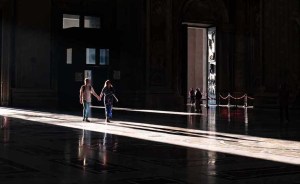Using Negative Space to Improve Your Image

Cosmos
Negative space simply refers to empty space around the subject (which is called positive space). The word negative in this case is not a bad connotation, but a way of guiding the viewer directly to the subject since the rest of the space has little to no visual interest. Negative space is relatively uniform, making it feel somewhat “empty” compared to the rest of the frame and the area is uninteresting because nothing is really happening in the space. Negative space is also called White Space for that very reason.

Swan, Lake of the Woods, Locust Grove, VA
While that might sound like a bad thing, when used with careful thought, negative space can accentuate your subject by reducing the visual competition in the frame and direct the viewer’s attention to the deeper story within your image. Negative space has “visual weight” in the image, so the addition or subtraction of negative space also affects the weight of the other elements in the image. And negative space does not actually have to be empty; sometimes, if you are careful about reading the light and setting your exposure, you can create it in the image by intentionally over- or underexposing different parts of the photo.
In many cases, negative space actually creates the mood or the emotion in the image and it can also strengthen the emotions created by the image, emphasizing the feelings created by your subject. In short, whatever message it is that you are trying to send – the emotions you want to convey, the story you want to tell, the use of negative space affects it all.

Acrobat, Smithsonian Folklife Festival, National Mall, Washington, D.C.
While all images have some negative space, it is the large amount of negative space that creates the minimalism and produces a tranquil effect. Images that have a lot of negative space are often very abstract, with stretches of blue sky, water or sand. The use of negative space isn’t confined to a single genre. In fact, you can apply this concept across various types of photography.

Sunset above the clouds
Travel photography also benefits from negative space. Imagine a road stretching through an empty landscape, or a person standing at the edge of a lake; the results are meaningful and striking at the same time. Even certain forms of street photography can look great with lots of negative space. A lone figure crossing a wide-open plaza can speak volumes about urban life and isolation.
Whether you’re capturing breathtaking landscapes, engaging street scenes, or intimate portraits, negative space can be a subtle yet profound element to explore.

Saint Peter’s Basilica, Rome, Italy
Here are some tips for creating images employing negative space:
- To create a minimalist composition, identify the main subject.
- Isolate the main subject by adjusting the focal length and camera angle.
- Eliminate as much color as possible to create uniformity. Perhaps just one or two colors in a very harmonious scene.
- Negative space can be used to convey emotion – let your image tell that story – one of sadness, loneliness or pleasure.
- Look for great expanses such as the sky for negative space. Get down low and point your camera up! This is a great way to simplify a chaotic scene.
- Convert your image to black and white to achieve the negative space needed, since all of the colors become shades of gray. The conversion doesn’t always work as well as you’d like, depending on the tones in the image, but it can sometimes create a stunning image.
- Make sure to eliminate background and peripheral distractions. Adjust the angle, slightly change position or wait for the right moment to press the shutter.
- Try a wide-angle lens to create a greater expanse and sense of scale in your image. Don’t have a wide-angle lens? Move with your feet!
- Balance the positive space (the subject) with negative space. The positive space/subject is what draws the eye, so it is more powerful in the image, while negative space is more subdued. Some photographers employ a 2:1 rule, having two parts negative space to 1-part positive space, but your image is your vision so this rule may or may not work for you.
Negative space is an immensely powerful element of every photograph, or at least it has the potential to be. It is a case when less (the subject) becomes more (emotion). Learning to use negative space well will certainly help you find not only new ways of composing your photographs, but also new ways to learn and tell the story of your subjects.
It is a compositional tool worth exploring.
Photos by Sherryl Belinsky
